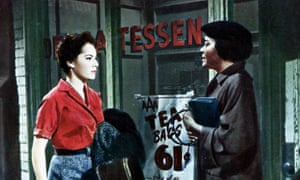‘Passing for white’: how a taboo film genre is being revived to expose racial privilege |
‘Passing for white’: how a taboo film genre is being revived to expose racial privilege
The Guardian
2018-08-20
Janine Bradbury, Senior Lecturer in Literature; School Learning and Teaching Lead
School of Humanities, Religion & Philosophy
York St John University, York, United Kingdom
 Crossing the colour line … Susan Kohner and Juanita Moore as daughter and mother in Douglas Sirk’s Imitation of Life (1959). Photograph: www.ronaldgrantarchive.com |
Rebecca Hall’sdirectorial debut is an adaptation of Nella Larsen’s 1929 novel Passing, a theme little seen since the likes of Show Boat and Pinky
Hollywood once loved films about passing. The genre was popular in the 1940s and 50s, when segregation was rife and the “one-drop rule” – which deemed anybody with even a trace of African ancestry to be black – prevailed. Box-office hits included Elia Kazan’s Pinky (1949) and George Sidney’s musical Show Boat (1951), which featured light-skinned, mixed-race characters who passed for white in the hopes of enjoying the privileges whiteness confers. The secrets, the scandal and the sheer sensationalism of it all made for excellent melodrama.
Now Rebecca Hall, the star of Vicky Cristina Barcelona and Red Riding, is revisiting the genre with her directorial debut, an adaptation of Nella Larsen’s seminal 1929 novel Passing. Tessa Thompson and Ruth Negga will feature in the project, which tells the story of childhood friends, Clare Kendry and Irene Redfield, who are both light-skinned enough to pass for white but choose to live on opposite sides of the colour line…
…How will Hall negotiate the tricky history of the genre? Even though it was a real-life phenomenon, most films about passing, including Pinky and Show Boat, have literary roots. William Wells Brown’s 1853 anti-slavery novel Clotel, which imagines the fate of Thomas Jefferson’s mixed race progeny, is perhaps the first American passing novel. Brown used passing to expose the arbitrary nature of white privilege. His mixed-race characters were a manifest symbol of the reality that many powerful, supposedly God-fearing white slaveholding men were coercing and raping enslaved black women and condemning their own children to a life in bondage (although, as Beyoncé recently revealed, not all unions were of this nature)…
Read the entire article here.
Tags: Janine Bradbury, Nella Larsen, Rebecca Hall, Ruth Negga, Tessa Thompson, The Guardian